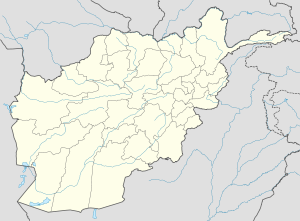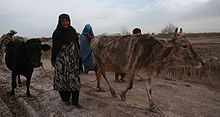- Marja, Afghanistan
-
Marja
مارجهLocation in Afghanistan Coordinates: 31°31′N 64°07′E / 31.517°N 64.117°E Country Afghanistan Province Helmand Province District Nad Ali Population [1][2][3] - Total 80-85,000 (disputed)
125,000 (with surrounding area - also disputed)Time zone UTC+4:30 Marja (also spelled Marjah or Marjeh) is an unincorporated agricultural district in Nad Ali District, Helmand Province, Afghanistan, southwest of Lashkar Gah, the provincial capital. The name Marja is also applied to a small location within the district where a number of farmers' markets, shops and a mosque are located. The population of the Marja district is 80,000 - 125,000 spread across 80 - 125 square miles (320 km2), an area larger than Cleveland or Washington D.C.. During the February 2010 Operation Moshtarak, the largely rural community of Marja was repeatedly described in the press as a "town" and even "city", following a 2 February 2010 briefing by US Marines.[4]
Contents
Population and economy
Marja is geographically situated in one of Afghanistan's major belts of poppy fields,[5] which are a source of funds for the Taliban.[6] According to one figure, 10% of global illicit opium production in the year 2000 originated from the Marja/Nad-i-Ali area.[7] During the 1950s and 1960s the United States government irrigated the fields around Marja (Lashkar Gah/Helmand was nicknamed "Little America"), with many canals remaining to this day.[1][6]
In conjunction with this American-led development, which included building and staffing a number of local schools, the Afghan government jump-started a program in 1959 to resettle Pashtun nomads to the area, providing them each with "almost 15 acres of land, two oxen and free seeds", with a focus on growing wheat.[8] Besides facing a number of technical problems, the development/resettlement program had the political aim of minimizing spillover of the Pashtun independence movement from across the Durand Line in Pakistan.[8]
Climate
Data collected in the 1950s in the Marja/Chah-i-Anjirs area showed an average rainfall of over one inch per month from December through March, peaking in January at 2.46 inches. The rest of the year experienced little or no precipitation, and besides January, there was actually a consistent net loss of water through evaporation. June, July, and August experienced average high temperatures of over 100 °F (38 °C), while the average lows in winter bottomed out at just above freezing in December and January.[9]
Afghan War
In May 2009 in a joint operation, international and Afghan troops killed 60 militants and seized a record amount of drugs during a four-day attack targeted at the town's bazaar, describing it as "a key hub for militant and criminal operations". The area was emptied of civilians and precision air strikes were employed resulting in seizure of 92 tonnes of poppy seeds, along with tar opium, processed morphine, heroin and hashish, "severely disrupting" an alleged narcotics center and command hub of the Taliban insurgency. The US military also said that a large amount of weapons and bomb-making equipment was seized during the operation.[10]
In July 2009, Afghan shopkeepers in Nawa, a town southeast of Marja, told the media that some 300 to 600 Taliban had left their village when a Marine battalion moved in and proceeded to retreat to Marja.[11] In December 2009 it was still called "the most fearsome Taliban stronghold in Helmand Province" in an area out of ISAF control during the Taliban insurgency. According to U.S. Marine commanders Marja was a sanctuary for some 1,000 fighters.[12]
2010 offensive
Marja was the target of Operation Moshtarak, a NATO-Afghan joint offensive involving 15,000 Afghan, Canadian, French, American, and British troops.[13] It constituted the largest joint operation of the war up to that point and aimed to remove the Taliban from Marja (described as a "town" or "city" of 80,000 - 125,000 inhabitants) and hold the area down, eliminating the last Taliban stronghold in Helmand. The operation was launched on 13 February 2010.
NATO and Afghan forces encountered heavy resistance from the Taliban but succeeded in forcing the insurgents to retreat. The intensity of the fighting increased as each day progressed and the Coalition started to suffer heavy casualties because of improvised bombs and Taliban sniper-fire.
During the February 2010 Operation Moshtarak, the rural agricultural district of Marja was repeatedly described in the press as a "town" or even "city", following a 2 February 2010 briefing by US Marines.[4] Population estimates varied from 80,000 - 85,000,[1][2] to around 125,000 when surrounding areas were included in the count.[3] Other observers expressed doubts over those estimates, believing them much too large when compared with overhead images of the area.[14][15] According to a report by the Institute for the Study of War, "Press reports suggest that Marjah is home to some 50,000 to 80,000 inhabitants, but they are likely referring to the entire district of Nad Ali. The population of Marjah itself and the surrounding villages is certainly less than 50,000".[16] Other experts associated with ISAF described Marja as a "rural community" and "a collection of village farms".[4]
References
- ^ a b c Thompson, Mark (2010-02-09). "U.S. Troops Prepare to Test Obama's Afghan War Plan". TIME. http://www.time.com/time/nation/article/0,8599,1962126,00.html?xid=rss-topstories. Retrieved 2010-02-09. "A town of 80,000, Marja..."
- ^ a b Perry, Tony (2010-02-03). "In Afghanistan, Marines ready attack on Taliban redoubt". Los Angeles Times. http://www.latimes.com/news/nation-and-world/la-fg-afghanistan-assault4-2010feb04,0,6261652.story. Retrieved 2010-02-03. "Marja, with a population estimated at 85,000..."
- ^ a b Marquez, Miguel (2010-02-03). "Afghanistan: Marines Gear Up for Biggest Fight Yet". ABC News. http://abcnews.go.com/International/afghanistan-us-marines-face-biggest-fight/story?id=9734858. Retrieved 2010-02-03. "Marja and the surrounding area, with an estimated population of 125,000..."
- ^ a b c Gareth Porter, Inter Press Service, 8 March 2010, Fiction of Marja as City Was U.S. Information War
- ^ Nordland, Rod (2010-02-03). "Military Officials Say Afghan Fight Is Coming". The New York Times. http://www.nytimes.com/2010/02/04/world/asia/04taliban.html?hp. Retrieved 2010-02-03.
- ^ a b Perry, Tony (2010-01-31). "Marine assault vehicles key to Afghan strategy". Los Angeles Times. http://articles.latimes.com/2010/jan/31/world/la-fg-afghan-marines31-2010jan31. Retrieved 2010-02-04.
- ^ Hafvenstein, Joel (2007). Opium Season: A Year on the Afghan Frontier. Globe Pequot. p. 157. ISBN 1599211319. http://books.google.com/books?id=QflBCoDVn30C&pg=PA157&dq=marja+afghanistan&num=100&cd=46#v=onepage&q=marja%20afghanistan&f=false.
- ^ a b Chandrasekaran, Rajiv (2010-02-10). "Marines plan joint mission to eject insurgents from last Helmand stronghold". The Washington Post. http://www.washingtonpost.com/wp-dyn/content/article/2010/02/09/AR2010020903511_pf.html. Retrieved 2010-02-10.
- ^ Michel, Aloys Arthur (1959). The Kabul, Kunduz, and Helmand Valleys and the national economy of Afghanistan: a study of regional resources and the comparative advantages of development. National Academies. pp. 142–145. http://books.google.com/books?id=yk0rAAAAYAAJ&printsec=frontcover&source=gbs_v2_summary_r&cad=0#v=onepage&q=&f=false.
- ^ "'Record' Afghanistan drugs bust". BBC News. 2009-05-23. http://news.bbc.co.uk/2/hi/8065545.stm. Retrieved 2010-02-03.
- ^ Oppel, Richard A. (2009-12-04). "Marines Lead Offensive to Secure Southern Afghan Town". The New York Times. http://www.nytimes.com/2009/12/05/world/asia/05kabul.html?scp=1&sq=Marines%20Lead%20Offensive%20to%20Secure%20Southern%20Afghan%20Town%20&st=cse. Retrieved 2010-02-03.
- ^ Schmitt, Eric (2009-12-26). "Elite U.S. Force Expanding Hunt in Afghanistan". The New York Times. http://www.nytimes.com/2009/12/27/world/asia/27commandos.html. Retrieved 2010-02-03.
- ^ Thompson, Mark (2010-02-09). "U.S. Troops Prepare to Test Obama's Afghan War Plan". Time. http://www.time.com/time/nation/article/0,8599,1962126,00.html. Retrieved 11 February 2010.
- ^ Foust, Joshua (2010-02-15). "Spinning Moshtarak?". Registan.net. http://www.registan.net/index.php/2010/02/15/spinning-moshtara/. Retrieved 2010-02-23.
- ^ Girishki, Anahita (2010-02-18). "Krieg um die Phantomstadt Mardscha". eigentümlich frei. http://ef-magazin.de/2010/02/18/1875-afghanistan-krieg-in-der-phantomstadt-mardscha. Retrieved 2010-02-18.
- ^ "Operation Moshtarak: Preparing for the Battle of Marjah". Institute for the Study of War. 2010-02-11. http://www.understandingwar.org/files/Operation_Moshtarak_1.pdf. Retrieved 2010-02-23.
Further reading
- Gareth Porter. "Marjah: The Non-Existent City the Military Said We Conquered in Afghanistan". AlterNet. http://www.alternet.org/world/145971/marjah%3A_the_non-existent_city_the_military_said_we_conquered_in_afghanistan.
- David Guttenfelder. "Marjah offensive: Q&A on why it matters to Afghanistan war". Christian Science Monitor. http://www.csmonitor.com/World/Asia-South-Central/2010/0209/Marjah-offensive-Q-A-on-why-it-matters-to-Afghanistan-war.
Categories:- Populated places in Helmand Province
Wikimedia Foundation. 2010.



